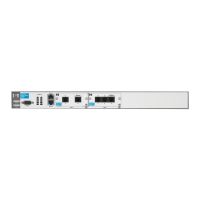B-42
Appendix B: Glossary
Q
QoS Quality of Service. The “quality” of the packet forwarding service provided to
a packet. A value set in the packet’s ToS field can request a specific level of
QoS. QoS mechanisms regulate and manage traffic across a WAN link to lower
latency for high-priority packets and to increase the quality and speed of data
transmissions. QoS mechanisms include queuing methods, buffering, drop-
ping of excess traffic, and traffic shaping. For more information on current
QoS architecture, see RFC 2990 (at http://www.ietf.org/rfc/rfc2990.txt). See
also DiffServ, FRTS, GTS, IP precedence, LLQ, and WFQ.
QSIG Q SIGnaling. An channel-signaling protocol based on ISDN Q.931 standards
and used by many digital PBXs. QSIG is used for to establish and release calls
and to control many call features.
R
R-interface In an ISDN network connection, the R interface connects the TE2 to the TA.
RADIUS Remote Authentication Dial-In User Service. An AAA protocol that allows a
server to store all the security information for a network in a single, central
database. The server stores and manages user information so that it can
authenticate these users. The server also maps users to the services that they
are allowed to access. For more information on RADIUS, see RFC 2865 (at
http://www.ietf.org/rfc/rfc2865.txt).
RADSL Rate Adaptive DSL. By using DMT modulation, RADSL can adapt to varying
line conditions to maximize the transmission speed on a particular line. Since
standard ADSL also does this, there is little difference between RADSL and
ADSL.
RAL Ringer Approximated Loading. See REN.
RAS Remote Access Server. A server that is dedicated to handling users that are
not on a LAN but need remote access to it. The remote access server allows
users to gain access to files and print services on the LAN from a remote
location.
RBOC Regional Bell Operating Companies. The United States’ Regional telephone
companies (or their successors) that were created as a result of the breakup
of American Telephone and Telegraph Company (AT&T, known also as the
Bell System) by a United States Federal Court consent decree on December
31, 1983. The seven original RBOCs were Ameritech, Bell Atlantic, BellSouth,
NYNEX, Pacific Bell, Southwestern Bell, and US West. Each of these

